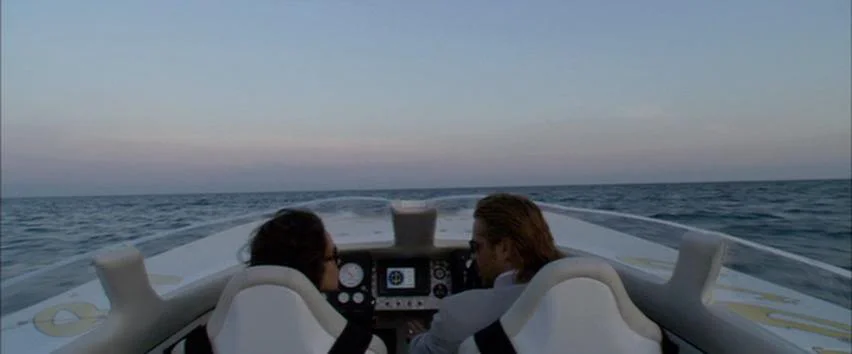RetroReview by Nadine Smith
There have been a hundred thousand words better than mine written about Michael Mann’s Miami Vice (written by the likes of Calum Marsh for Reverse Shot; Jean-Baptiste Thoret for Sense of Cinema; Fernando F. Croce for Cine Passion; Keith Uhlich for Slant Magazine; and many others), and there will be a hundred thousand more, since little seems to stand in the way of Miami Vice’s ascendancy to the top of the rapidly reforming canon of cinematic greats. Is it an overstatement to call Miami Vice the Citizen Kane of its day? Maybe, but both Kane and Vice were met with little more than a shrug upon release, except Miami Vice was also nominated for a Teen Choice Award. I don’t think Orson Welles ever got one of those.
It doesn’t matter what Miami Vice is about (the combination of those two words, “Miami” and “Vice,” is more potent than plot description), or even how it is about it. What matters is that it is.
As with so many of the greatest movies, Miami Vice only exists while you’re watching it, like a trick of the light. But the extraordinary thing is that the language Mann communicates with is computer file, not celluloid. Film itself is a synecdoche, a physical medium standing in for an artistic one, and we have long projected our own preoccupations with tangible media onto it as a whole. Physical film somehow seems more natural, more human, more capable of emotion and eroticism and feeling. Like us, film ages, film wears, film loses what it once had and gains something else in the process. Digital decays too, but it’s a conscious decay; we ourselves have to interact with digital recordings before they can disintegrate.
Temporality alone is not enough to whittle away at digital. Mann’s trick is less one of light alone and more of pixel; the trick is that digital, for all its inhumanity, for its perceived lack of ontology or tangibility, can be more human than that which we think is most human.
There is something here that immediately strikes us as more “real”: the way night doesn’t just dissolve into a blue-black mess of indiscernibility or how the camera shakes when guns pop and glass breaks. Or that grand moment in which Michael Mann unintentionally gave genesis to Film Twitter, the collision of the Universal logo into “Numb/Encore,” the lack of opening credits and extradiegetic context. There is an immediacy, a clarity, and a sense of structure here that cannot be accomplished with film. Like we conflate celluloid with a sort of naturalism, we assume the synonymy of video with documentary and TV news aesthetics.
But there’s also something artificial. This is a world in which it always thunders but never rains. Insider jargon clouds our understanding of otherwise pedestrian plot mechanics, and in its wake leaves a string of images, articulated moments in a morning fog: hands clasped on a hospital bed, bodies enshrouded by the steam of showers, a cigarette boat slicing through an unfamiliar ocean, lovers entangled in a dance while a menace watches from afar.
Miami Vice is architecture of feeling. It is sewn out of sensuality, built out of a potency and palpability that only cinema can construct: gestures, glances, the playful glow of the light on wet skin.
For all our talk of how it drives us apart, we have forgotten the promise, one that can still be delivered, of digital technologies: the potential for connectivity, the dissolution of private and public space into a singular present tense in which we are all brought together across distance, language, and time. It offers the ability to get lost in hyperlinks, not with yourself or your own conjuring of reality, but with friends and lovers, near and close, real and imagined, URL and IRL. Every moment could be interaction, stimulation, conversation. Digital allows for a greater sense of being. Miami Vice is, as Matt Zoller Seitz put it, “zen pulp,” but it is most of all a digital melodrama, two lovers slicing through their unfortunate situations to find a common ground, to build their own culture against outside forces and beat back together against the current. Miami Vice delivers on the promise of digital; Miami Vice is Babel undone.
The old screenwriting adage goes “show, don’t tell.” But narrative itself is telling, because it is predicated on the existence of written language. My words are hyperbolic, but what else do you expect when I want to use language to describe a series of images far beyond the scope of language?
Words are symbols, representing things we feel and want to say, and plots are constructed out of words; by evading plot, Miami Vice evades semiotics and cuts straight to emotion. Miami Vice goes further than that aforementioned piece of advice. Don’t show. Don’t tell. Be.

